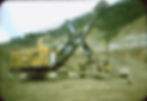Reopening Panguna Mine: A Cooperation Opportunity for Australia
- Jun 9, 2024
- 4 min read
Sebastian Salay |

Panguna mine - Bougainville. Image sourced via Wikimedia Commons.
For 35 years, giant bulldozers have rusted in Panguna mine. Workers’ barracks and offices slowly collapsed. The mountain is hollowed out and the mine tailings have turned the river a toxic, vivid blue. These remains are a poignant reminder of the social upheaval and environmental damage that Panguna mine caused on Bougainville Island. Now, the Autonomous Bougainville Government (ABG) wants to reopen the mine. From the Australian government’s perspective, Panguna’s reopening could pose a serious conflict risk. However, if carefully considered, the mine could offer a significant opportunity for cooperation and facilitate reconciliation for historical injustices caused by Australia’s extractive colonial legacy. To achieve this, Australia must learn from the past by ensuring that any assistance given recognises Bougainvillean sovereignty and that the mine benefits Bougainvilleans.
The Panguna mine has played a central role in the island’s history. In 1969, while the Territory of New Guinea was a colony administered by Australia, Bougainville Copper Limited (BCL), a subsidiary of Rio Tinto Australia, dug one of the biggest open-pit copper mines in the world. When Papua New Guinea (PNG) declared independence from Australia in 1975, its 20 per cent stake in the mine became the government’s biggest income stream. By contrast, Bougainvilleans received a tiny share of the profits and jobs created by the mine while bearing the brunt of the environmental and social impacts. In 1988, frustrated by this inequity, Francis Ona, a former BCL employee, established the Bougainville Revolutionary Army (BRA) to disrupt BCL’s operations and fight for Bougainvillean independence. For a decade, the BRA, the PNG Defence Force (PNGDF), and other armed factions fought a guerrilla war that caused around 20,000 deaths, mostly among civilians.
Today, many Bougainvilleans still associate Panguna with Australia’s colonial legacy. Rio Tinto made millions by extracting Bougainville’s copper and is now slow to fund environmental remediation in the area. Local suspicion towards Australia is compounded by Australia’s indirect support to the PNGDF during the military campaign of the 1990s, including donating helicopters. More recently, Australia’s Deputy Prime Minister Richard Marles was accused by ABG President (and former BRA commander) Ishmael Toroama of “intimidation” and making “veiled threats” towards Bougainville after Marles misspoke and misrepresented Australia’s official neutral position as supporting PNG in the delicate negotiations over the province’s political future.
If the ABG succeeds in reopening Panguna, it would be politically symbolic and economically rewarding. A reopened Panguna would represent Bougainvilleans finally taking charge of their affairs after decades of colonialism, occupation, and administration by others. The royalties from the 5.3 million tonnes of copper and 19.3 million ounces of gold that are estimated to still reside under Panguna would bankroll Bougainville’s goal of independence from PNG, while the mine operations could employ hundreds of Bougainvilleans. Further, re-opening the mine would require new investment in infrastructure like roads, bridges, essential services, and ports, creating economic and employment opportunities for Bougainvilleans living near the mine.
On the other hand, a reopened mine could plunge Bougainville back into conflict. Some landowners around the mine are wary of the plan to reopen Panguna and could protest against the government’s decision to reopen it. The ABG’s direct consultation with landowning clans may mitigate this risk. However, Bougainvilleans elsewhere on the island will be eager to ensure that royalties are properly allocated and benefits from the mine are distributed equitably, as any perceptions of mismanagement may incite discord. While a return to outright conflict is unlikely, increasing tensions on the island could have dramatic implications for the region, especially for Australia given its longstanding connections to both PNG and Bougainville.
As a key development partner, Australia could play a critical role in this symbolic, nation-building project while ensuring that the reopening of the mine does not escalate tensions. Doing so will be an important step in rebuilding trust and repairing the Australia-Bougainville relationship. Currently, Australia funds a range of initiatives in Bougainville that can be understood as serving as a form of reparations for past injustices. As Bougainvillean citizens continue to reconcile in the wake of the civil war, these projects present opportunities for Australia and Bougainville to mend relations at the national level. To ensure success, Australia must learn from past mistakes and prioritise the needs of Bougainvilleans above the relentless pursuit of profits.
Panguna is complex because it encapsulates competing demands for self-determination, economic development, environmental protection and the maintenance of genuine peace. It also constitutes a rare opportunity for productive collaboration that could help to mend the Bougainville-Australia relationship. If carefully managed, a partnership between Australia and Bougainville could see the peaceful and successful reopening of Panguna, and herald a new and promising era of bilateral cooperation.
Sebastian Salay is a political anthropologist and Research Fellow at University of Melbourne. His research explores urban settlements and customary land agreements in Port Vila, Vanuatu. He has also done research with West Papuan musicians in Melbourne and critical anthropological practice in Britain. Previously, he worked on disability advocacy and youth policy in Victoria, Australia, and building peace in Bougainville.
Sebastian has a Bachelor of Arts (Politics & International Studies and Anthropology) with Honours in Anthropology from the University of Melbourne, and a Master of Science in Social Anthropology from the University of Oxford.